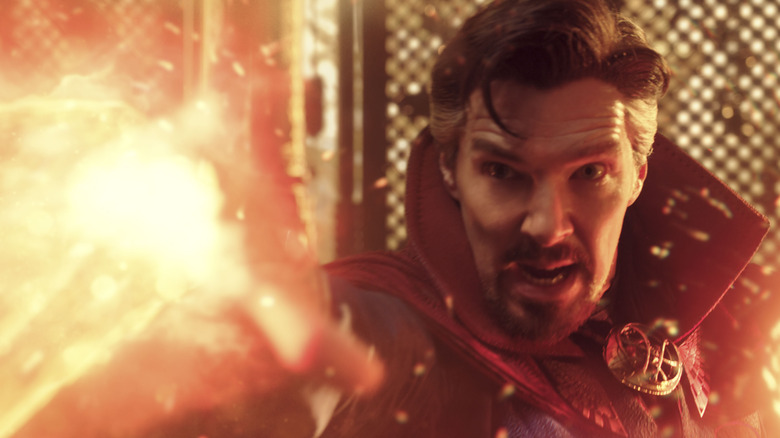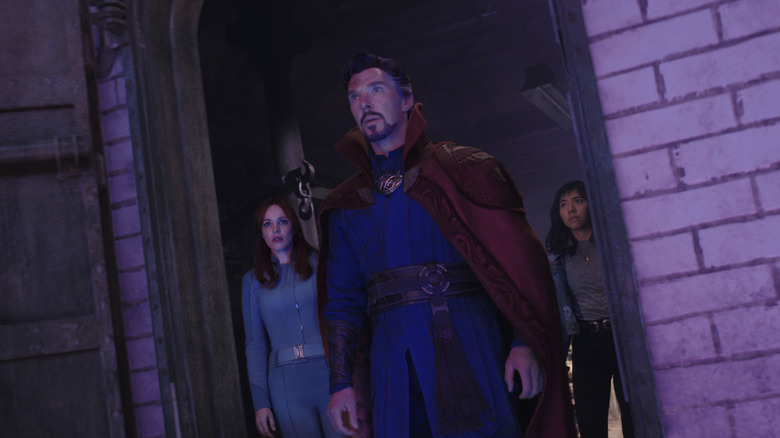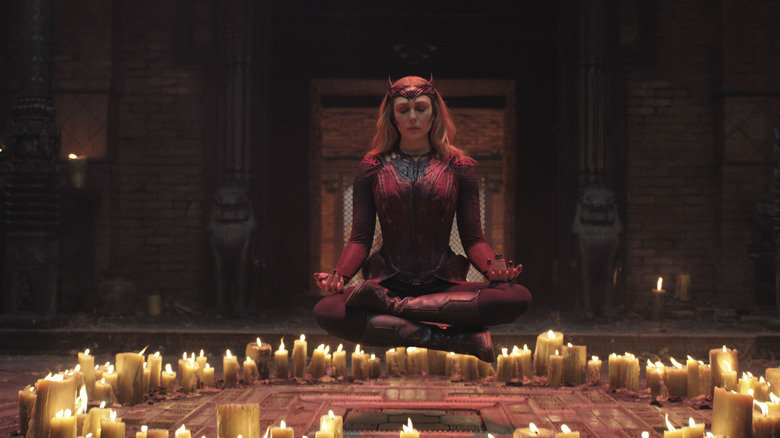Doctor Strange In The Multiverse Of Madness Review: A Sam Raimi Marvel
What does a Sam Raimi Marvel movie look like? That's the big question going into "Doctor Strange in the Multiverse of Madness," a sequel whose obligations to the Marvel Cinematic Universe at large are written all over its clunky title and its alarmingly big ensemble of superheroes and supervillains alike. We know what a Raimi superhero movie looks like, and even what a Raimi love letter to Marvel's most beloved web-slinger looks like. But how does the horror auteur behind such works as "The Evil Dead" work within the confines of the Marvel Studios machine? The answer is a little complicated.
Raimi has gone into overdrive downplaying how much his distinct directorial style shows up in "Multiverse of Madness," promising that he's playing nice with the Marvel house style. And while that appears to be painfully true for much of the first half of the "Doctor Strange" sequel, Raimi and all of his campy, cheesy quirks can't help but pop to the surface. The result is a horror-tinged trip that is as macabre and gnarly as Marvel has ever been, and as muted as Raimi has ever been. But even at his most muted, Raimi gives us one hell of a ride.
Sam Raimi, leashed
"Doctor Strange in the Multiverse of Madness" can't hide the fact that its main purpose is to bridge the gaps between the rapidly expanding Marvel properties — within the first half-hour it namedrops Spider-Man, makes multiple callbacks to The Blip, and fast-forwards through an explanation of how the multiverse works (we've been talking about it for two movies and several TV shows now, move on).
Which is why it's jarring when its opening drops you right in the middle of a video game cut scene between America Chavez (a spunky and spirited Xochitl Gomez) and an alternate Doctor Strange, fleeing from the giant tentacled monster, Gargantos. A very Marvel fight ensues, full of CGI beams and whips, which ends in America accidentally activating her powers of punching through the multiverse and landing her in our Stephen Strange's (Benedict Cumberbatch, dutifully snarky) Earth, right outside of the wedding of Strange's former flame, Christine Palmer (Rachel McAdams, given something to do this time!). With the help of the new Sorcerer Supreme Wong (Benedict Wong, always scene-stealing), Doctor Strange saves America and inadvertently steps in as her guardian when it becomes clear that the demons pursuing her could result in her multiverse-hopping powers falling in the wrong hands. Those hands belong to Wanda Maximoff (a magnificent Elizabeth Olsen, at once wounded and arch), who has emerged from the depths of "WandaVision" as the villain of the story, now intent on finding a universe where she can be reunited with the real versions of her fake children.
"The Multiverse of Madness" hits the ground running and never once stops, which is in equal turns exhausting and industrious. It's here that you can feel that Marvel machine at work, "Loki" scribe Michael Waldron's script hitting all the plot points and exposition with ruthless efficiency, in a frenzied pace that could almost be admirable in how it doesn't wait for the audience to catch up. But as the movie starts to settle into a rhythm, something else catches up: the Raimi of it all.
Sam Raimi, unleashed
At first Raimi's stylings pops up in little things: the hokey wipe transitions, a particularly dedicated extra or two, goofy overlays of characters during long exposition dumps, people screaming at the camera in extreme close-up. But the way that Raimi's influence most obviously exerts itself is in the surprising brutality of "Multiverse of Madness." Marvel has often cut away from violence in favor of a more sanitized view of superheroes, but "Multiverse of Madness" flirts with horror in a manner that gives us some of our goriest deaths yet — an impaled eyeball, a bisected person, an exploded head, and one unfortunately placed metal fence are just a sampling of how gruesome "Multiverse of Madness" can be. It feels like Raimi acting in direct opposition to the fan service that he's called upon to enact — you might even say that he kills the fan service in such a hilariously vicious way that it could only be intentional.
And in the way that Raimi's stylings start to become more prominent, so do the director's own affinities for the film's characters. It's clear that Raimi doesn't care one lick about Stephen Strange — the titular superhero barely getting a character arc beyond "Isn't it sad he can't be with the love of his life?" But Wanda Maximoff, Raimi loves. Though she is unquestionably the villain of the movie, Wanda is afforded the internality that Stephen Strange isn't, and Olsen runs away with the film in her tortured, grief-stricken depiction of Wanda's downward spiral as she's driven to terrible deeds in the name of her children. Even when Olsen morphs into a terrifying bloodstained gremlin who leaps out of reflections with red eyes and crooked limbs — the embodiment of the film's horror tendencies, and the center of some of the movie's best scenes — she maintains the emotional core of the movie. It's a bit of a shame that Wanda's depiction futzes around with her arc from "WandaVision," but Olsen is so good in the movie that it's almost forgivable.
As the film goes on, it starts to embrace these Raimi-isms until the third act unleashes some of the director's most recognizable visual quirks in all their glory. It's silly, it's gory, it's a little "Evil Dead," a little "Darkman," and it's refreshingly cornball in a way that Marvel rarely is. It might be Raimi copping on his own directorial flairs within a Marvel movie — but at least he does it with style. Paired with Danny Elfman's fizzy score, Raimi elevates "Multiverse of Madness" from the bridge-building bit of IP it so transparently is. While he doesn't quite elevate it to the "madness" that the film promises, he does, for a few brief, shining moments, show the kids how those superhero movies could be done.
/Film Rating: 7.5 out of 10


